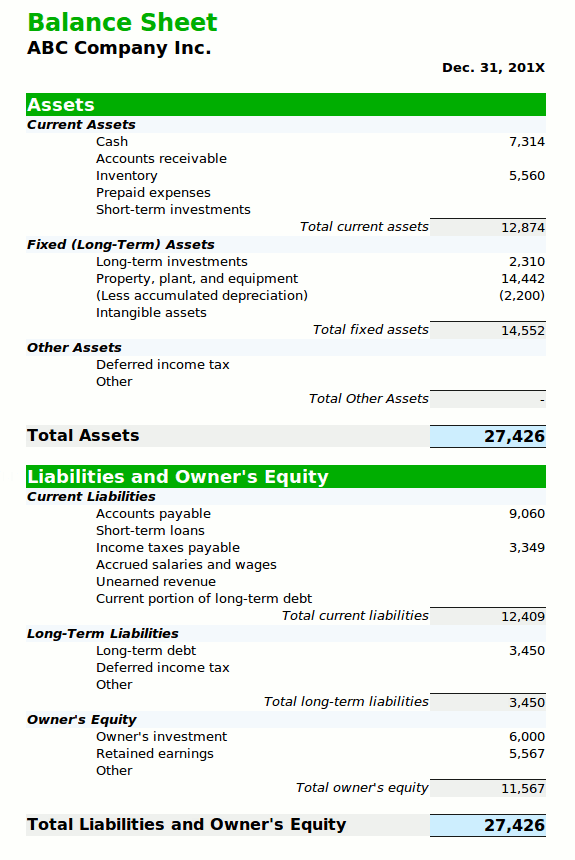Balance sheet
In financial accounting, a balance sheet or statement of financial position is a summary of the financial balances of a sole proprietorship, a business partnership, a corporation or other business organization. Assets, liabilities and ownership equity are listed as of a specific date, such as the end of its financial year. A balance sheet is often described as a "snapshot of a company's financial condition". Of the four basic financial statements, the balance sheet is the only statement which applies to a single point in time of a business' calendar year.
A business operating entirely in cash can measure its profits by withdrawing the entire bank balance at the end of the period, plus any cash in hand. However, many businesses are not paid immediately; they build up inventories of goods and they acquire buildings and equipment. In other words: businesses have assets and so they cannot, even if they want to, immediately turn these into cash at the end of each period. Often, these businesses owe money to suppliers and to tax authorities, and the proprietors do not withdraw all their original capital and profits at the end of each period. In other words businesses also have liabilities.

Balance Sheet
An example of a classified balance sheet.
Balance sheet analysis
Balance sheet analysis (or financial analysis) the process of understanding the risk and profitability of a firm (business, sub-business or project) through analysis of reported financial information, particularly annual and quarterly reports.
Balance sheet analysis consists of 1) reformulating reported Balance sheet, 2) analysis and adjustments of measurement errors, and 3) financial ratio analysis on the basis of reformulated and adjusted Balance sheet. The two first steps are often dropped in practice, meaning that financial ratios are just calculated on the basis of the reported numbers, perhaps with some adjustments. Financial statement analysis is the foundation for evaluating and pricing credit risk and for doing fundamental company valuation.
Financial ratio analysis should be based on regrouped and adjusted financial statements. Two types of ratio analysis are performed: 3.1) Analysis of risk and 3.2) analysis of profitability:
3.1) Analysis of risk typically aims at detecting the underlying credit risk of the firm. Risk analysis consists of liquidity and solvency analysis. Liquidity analysis aims at analyzing whether the firm has enough liquidity to meet its obligations when they should be paid. A usual technique to analyze illiquidity risk is to focus on ratios such as the current ratio and interest coverage. Cash flow analysis is also useful. Solvency analysis aims at analyzing whether the firm is financed so that it is able to recover from a losses or a period of losses.
3.2) Analysis of profitability refers to the analysis of return on capital, for example return on equity, ROE, defined as earnings divided by average equity. Return on equity, ROE, could be decomposed: ROE = RNOA + (RNOA - NFIR) * NFD/E
Purposes of balance sheet analysis
"The objective of financial statements is to provide information about the financial position, performance and changes in financial position of an enterprise that is useful to a wide range of users in making economic decisions. " Financial statements should be understandable, relevant, reliable and comparable. Reported assets, liabilities, equity, income and expenses are directly related to an organization's financial position.
Financial statements are intended to be understandable by readers who have "a reasonable knowledge of business and economic activities and accounting and who are willing to study the information diligently. " Financial statements may be used by users for different purposes:
- Owners and managers require financial statements to make important business decisions that affect its continued operations. Financial analysis is then performed on these statements to provide management with a more detailed understanding of the figures. These statements are also used as part of management's annual report to the stockholders.
- Employees also need these reports in making collective bargaining agreements (CBA) with the management, in the case of labor unions or for individuals in discussing their compensation, promotion and rankings.
- Prospective investors make use of financial statements to assess the viability of investing in a business. Financial analyses are often used by investors and are prepared by professionals (financial analysts), thus providing them with the basis for making investment decisions.
- Financial institutions (banks and other lending companies) use them to decide whether to grant a company with fresh working capital or extend debt securities (such as a long-term bank loan or debentures) to finance expansion and other significant expenditures.
- Government entities (tax authorities) need financial statements to ascertain the propriety and accuracy of taxes and other duties declared and paid by a company.
- Vendors who extend credit to a business require financial statements to assess the creditworthiness of the business.
- Media and the general public are also interested in financial statements for a variety of reasons.